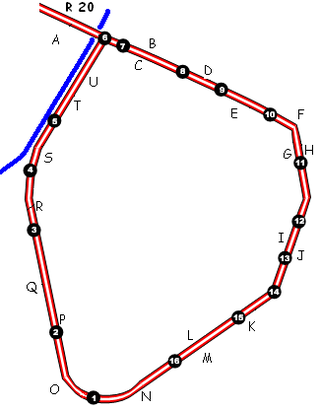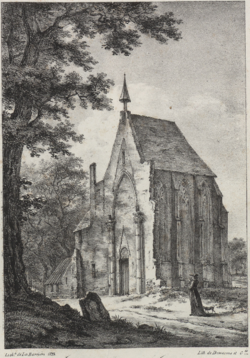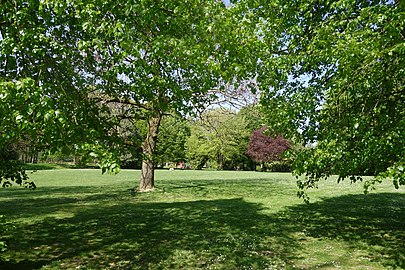
Anderlecht is one of the 19 municipalities of the Brussels-Capital Region, Belgium. Located in the south-western part of the region, it is bordered by the City of Brussels, Forest, Molenbeek-Saint-Jean, and Saint-Gilles, as well as the Flemish municipalities of Dilbeek and Sint-Pieters-Leeuw. In common with all of Brussels' municipalities, it is legally bilingual (French–Dutch).

La Roue (French) or Het Rad (Dutch), meaning "The Wheel", is a district of Anderlecht, a municipality of Brussels, Belgium. Located in the south of Anderlecht, it is one of this municipality's largest districts of and one of Brussels' main garden cities. Built in the 1920s, with its modest and picturesque houses, it offers a great vision of an early 20th-century working class neighbourhood. It is also home to one of the largest agribusiness industry campuses in Belgium: the Food and Chemical Industries Education and Research Center (CERIA/COOVI), as well as popular department stores.

The CICM Missionaries, officially known as the Congregation of the Immaculate Heart of Mary and often abbreviated as C.I.C.M, is a Catholic clerical religious congregation of Pontifical Right for men established in 1862 by the Belgian Catholic priest Theophile Verbist (1823–1868). Its members add the post-nominal letters C.I.C.M. to their names to indicate membership in the congregation.

St Andrew's Church in Brussels (Ixelles) is a congregation in membership of both the Church of Scotland and the United Protestant Church in Belgium (EPUB/VPKB) Services are conducted in English. The congregation's mission statement is "We aspire to follow Jesus in bringing the knowledge of God's love to all".
The Roman Catholic Archdiocese of Kananga is the Metropolitan See for the Ecclesiastical province of Kananga in the Democratic Republic of the Congo. The episcopal cathedral is the Cathédrale Saint Joseph Mikalayi in Kazumba. The Pro-cathédrale Saint Clément is in Kananga.

Malou Park is an urban park in the Woluwe-Saint-Lambert municipality of Brussels, Belgium. It is in the valley of the Woluwe stream, to the south-east of the Woluwe Shopping Center. It is the municipality's oldest and biggest park.

The Small Ring inner ring road, formally R20 and N0 is a series of roadways in central Brussels, Belgium, surrounding the historic city centre. The city centre is usually defined as the area within the Small Ring; this area is called the Pentagon due to its pentagonal shape. The pentagon forms the core of the City of Brussels municipality.
Paul Splingaerd was the Belgian foundling who became an official or mandarin (bureaucrat) in the late Qing government. As both a Belgian and a Chinese mandarin, Paul acted as a liaison on various Sino-Belgian projects in the late nineteenth century. The best known are the negotiations for Belgium to build the first major railway in China, the Beijing-Hankou Railroad and the development of a Belgian-Chinese industrial, mining and commercial enterprises in Lanzhou, the capital of Gansu province. Although better known in China where he was known by many names, including Lin Fuchen, Su Pe Lin Ge Er de (斯普林格尔德), Lin Balu Lin Bao luo, Bi lishi Lin, Lin Darin, Lin Ta Jen, in European circles he developed the reputation for being the "Famous Belgian Mandarin." Paul also initiated negotiations for the First Iron Bridge Across the Yellow River in Lanzhou, China, now known as Zhongshan Bridge, but died before it was built.
The Greater Ring or Intermediate Ring in Brussels, Belgium is a set of roads in the shape of a ring, intermediate between the Small Ring and the main Brussels Ring motorway. The greater part of this set of roads is numbered R21 and is about 30 km long, compared to 8 km for the Small Ring and 80 km for the main Ring.

The Brussels Ring numbered R0, is a ring road surrounding the city of Brussels as well as other smaller towns south of Brussels. It is about 75 kilometres (47 mi) long, with 2 or 3 lanes in each direction. While most of it is classified as a motorway (highway), part of it is merely an express route. It crosses the 3 regions of Belgium: its main part is situated in Flanders, whereas Wallonia comprises 18.2 kilometres (11.3 mi) of the total stretch and 5.5 kilometres (3.4 mi) is on Brussels territory.

The tram route 82 in Brussels, Belgium, is a tram route operated by STIB/MIVB, which connects Berchem-Sainte-Agathe railway station in Berchem-Sainte-Agathe to Drogenbos Castle in the Flemish municipality of Drogenbos. After 8 p.m., the route terminates at Brussels-South railway station, with connections to Drogenbos provided by tram route 32.

The Brussels International Exposition of 1897 was a world's fair held in Brussels, Belgium, from 10 May 1897 through 8 November 1897. There were 27 participating countries, and an estimated attendance of 7.8 million people.

Theophile Verbist, CICM was a Belgian Catholic priest who founded the Congregation of the Immaculate Heart of Mary, a missionary religious congregation of men. He led missionary activities in China.

Joris Six was a bishop of the titular diocese of Baliana in Algeria, and apostolic vicar of the vicariate-general Leopoldstad in Belgian Congo.

Léon Van Dievoet was a Belgian architect, painter, engraver, and draughtsman.
Félicien Ntambue Kasembe, CICM is a Congolese priest of the Catholic Church and a member of the Congregation of the Immaculate Heart of Mary. He is the bishop-elect of the Diocese of Kabinda, having been appointed to the position in 2020. Before he became a priest, he did missionary work in Taiwan, Hong Kong, Singapore and Mongolia.
Raphaël Marie Joseph de la Kethulle de Ryhove, nicknamed Tata Raphaël or Sango Raphaël, was a Belgian Scheut missionary priest in the Belgian Congo.
Alphonse Frédéric De Moerloose, born in Gentbrugge, Belgium, on 12 January 1858, died in Schilde, Belgium, on 27 March 1932 was a priest of the Congregation of the Immaculate Heart of Mary [CICM] and a Belgian architect. He was a missionary in China from 1885 to 1929 and built several Catholic churches in Inner Mongolia and North China.


















